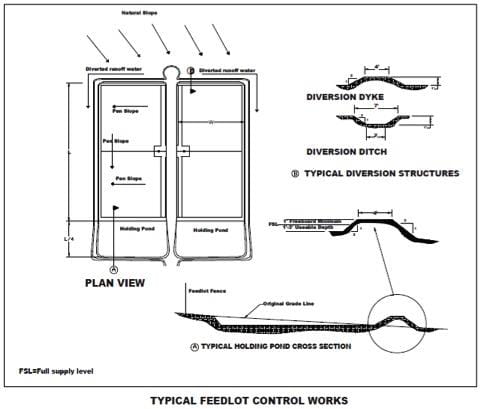Design holding ponds for at least 7.5 cm (3 in.) of runoff from the contributing area. Many jurisdictions use the volume of a one in 25-year/24-hour rainfall event to determine the holding pond volume. For Saskatchewan, this corresponds very closely to 7.5 cm (3 in.). Some locations may require additional volume based on site-specific details.
Small holding ponds
Small holding ponds are usually designed as evaporation ponds that allow natural evaporation to remove some, or all, of the water that collects. This requires a large surface area in relationship to the liquid depth, which is usually about 30 cm (12 in.). The shallow depth may allow you to seed the pond to grass. With shallow side slopes on the holding pond, it is often possible to drive through the pond to cut hay in it. The shallow water depth reduces the risk of seepage.
Holding ponds are often located adjacent to the pens. Where this is not practical, ditches can be used to direct runoff to a holding pond from another location on the site. Deep holding ponds are commonly used in large feedlots. They do not require as much surface area and may fit better into the site, but may require emptying.
All holding ponds are required to have at least 30 cm (12 in.) of freeboard (the vertical depth above the full supply level [FSL] which is provided as a factor of safety against overflow). You should have a plan and be prepared to reduce the liquid level below the FSL when necessary.
Holding pond construction and monitoring

The construction technique used for holding ponds will determine the effectiveness of the soil-seal formed.
The basic construction standard for holding ponds is to disc the final surface on the bottom and sides to a six-inch depth and then compact with a sheeps-foot packer.
- Place soil for dikes in six-inch lifts and compact with a sheeps-foot packer.
- Do not use topsoil for the construction of dikes.
Soil performance is greatly improved by using the proper construction techniques. A detailed site investigation will allow an engineer to recommend construction techniques that will ensure groundwater safety.
Geologically sensitive sites may lead to installation of sampling wells to monitor seepage from holding ponds and to determine the effect on groundwater quality. A regular monitoring program will allow corrective action to be taken when necessary. It is preferable to locate holding ponds on sites where monitoring is unnecessary.

